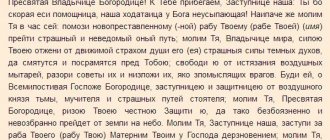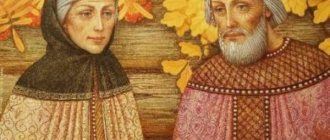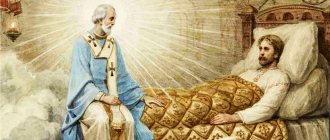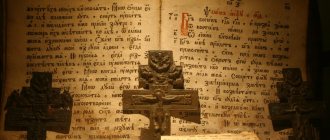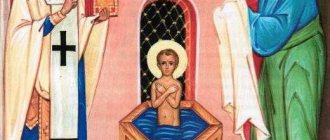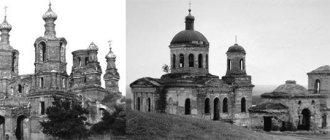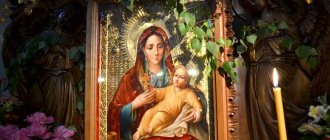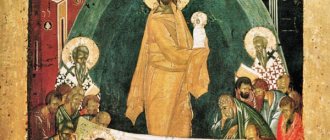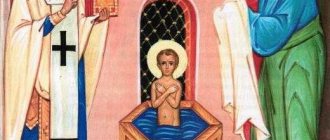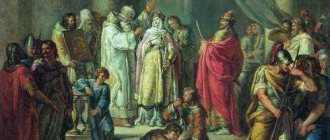One of the most tragic pages in the history of Russia in the 20th century was the murder of the royal family, dictated, as the Bolsheviks claimed, by “revolutionary necessity.” The victims of this inhuman logic were not only Nicholas II, who became the last representative of the three-hundred-year-old Romanov dynasty, but also his wife, Empress Alexandra Feodorovna, their four daughters aged from 17 to 23 years and the heir to the throne, 14-year-old Tsarevich Alexei. People who remained faithful to them in this last hour were also killed: both family members and those from their immediate circle.
History of the icon
The sin of murdering God’s anointed one weighed heavily on Russia for many decades, and only at the turn of the millennium, in 2000, the murdered Emperor Nicholas II and his family were canonized by the Russian Orthodox Church as royal martyrs. To glorify the new saints, icons of the Romanov royal family appeared.
The second icon associated with the Romanovs was the image of the Mother of God “Sovereign”, found on March 2, 1917 in the village of Kolomenskoye near Moscow. On the same day, the last Russian Tsar Nicholas II was forced to abdicate the throne for himself and for his son, Tsarevich Alexei, in favor of his brother, Grand Duke Mikhail Alexandrovich.
Since the abdication took place contrary to the laws of the Russian Empire (the tsar could not abdicate both for himself and for his son), it could not be considered legitimate. Nicholas II understood this, since he was well aware of all the intricacies of the law on succession to the throne. Grand Duke Mikhail Alexandrovich, in any case, according to the laws of the Russian Empire, could not be a tsar, since he entered into a morganatic marriage several months before the 300th anniversary of the House of Romanov, which became scandalous news of that time.
Emperor Nicholas II received the news of Prince Mikhail's marriage to the ex-wife of his colleague painfully, because he believed that a sense of duty to the country should be the main motive for the actions of any representative of the House of Romanov.
The revolutionary officers and cadets who forced the Tsar to abdicate in favor of Prince Mikhail could not help but know that they were offering a obviously illegitimate ruler. Perhaps that is why Nicholas II agreed with the formulation of illegal abdication. He expected the reaction and support of Russian society.
In the spring of 1917, the public greeted the February Revolution with joyful enthusiasm and remained indifferent to the news that the royal throne was empty. The discovery of the “Sovereign” icon on the day of the Tsar’s abdication began to be perceived by believers and those who remained faithful to monarchist beliefs as a sign that power over Russia had passed under the leadership of the Mother of God and Her Divine Son.
The story of the acquisition of the icon is complex and resembles an unusual and confusing plot of a tragic story with a happy ending.
Long decades of godlessness passed, and a third icon associated with the Royal House of Romanov was found in Altai. The story of the acquisition of the icon is complex and resembles an unusual and intricate plot of a tragic story with a happy ending.
However, the icon of the Romanovs serves not only to glorify the innocent murdered, but also for the repentance of the people guilty of the sin of apostasy from God’s anointed and leaving him along with innocent children in the hands of enemies. This sin is aggravated by the fact that neither the family nor those close to them during the arrest and detention tried to resist, humbly accepting the Will of God with Christian meekness. This sin, which still weighs heavily on Russia, will have to be atone for more than one generation.
Therefore, it is not surprising that today the icon of the holy royal passion-bearers is in almost every Orthodox church, and many believers have it in their homes. This is the meaning of the icon of the royal martyrs - to remind all of us, both believers and non-believers, of the martyrdom of the royal family, which was accomplished in the name of peace on Russian soil and once again confirmed the inviolability of the foundations of Orthodoxy in the Russian state.
The history of the iconographic perpetuation of the Russian martyr Tsar is amazing and similar to a legend. It reflected one of the sad paradoxes of the 20th century. The icon of Nicholas 2, the last Russian emperor, was painted even before his canonization in Russia - on the other side of the ocean, in the USA. In 1997, the Russian emigrant Iya Shmit (nee Podmoshenskaya) had a dream in which she saw an icon depicting the emperor - a martyr in grand ducal robes.
A little earlier, the woman received a small inheritance, and she intended to donate it to some good cause. When she woke up, she already knew what she would do with the money. Iya Shmit turned to icon painter Pavel Tikhomirov, who lives in California, with a request to paint the icon of Nicholas 2, which she saw in a dream. They began to study the photo of the king, hoping to find a suitable subject and a facial expression similar to the one the woman had seen.
The icon of the long-suffering Russian emperor was painted several years before the martyrs of the royal family were canonized. To the right of the sovereign is depicted Nicholas the Wonderworker, his heavenly patron, and to the left is the righteous Job the Long-Suffering. The inscription below says that “this holy icon” was created to glorify the Martyr Tsar in Russia.
Brief biography of the king
The future tsar received an excellent education, he knew several European languages, understood history, and was politically savvy. Since childhood, he was raised in the traditional Orthodox faith, loved to go to church, and knew the divine services.
In his youth, Nicholas met his future wife, Princess Alice of Hesse-Darmstadt and immediately began to ask for blessings to marry her, but he received it a few years later, in 1884. The happy event coincided with the illness of his father, the reigning Emperor Alexander III. He died shortly before the wedding.
Before the wedding, the princess converted to Orthodoxy and entered into marriage under the name of Alexandra Feodorovna. The fact that Alice thought for a long time about changing her religion speaks of her deep inner religiosity. The royal couple had five children: four daughters - Olga, Maria, Tatiana and Anastasia, and an heir, Tsarevich Alexei.
Modern history still cannot give an unambiguous assessment of the personality of St. Nicholas II, however, the conciliar mind of the Church glorifies the last Russian Tsar in the rank of “passion-bearers” or martyrs. Nikolai Alexandrovich Romanov was canonized in 1981, first by the Russian Church Abroad. In Russia, repentant understanding of the tragic death of the royal family occurred later.
Myrrh-streaming image
It was the whole family that was glorified by the Church, so many icon painting theorists believe that depicting St. Nicholas separately, not entirely true. However, there are examples when the veneration of an individual saint goes beyond the established canon. Thus, the prototype of the famous miraculous “myrrh-streaming” icon, which partly served as the basis for the creation of a separate iconography of the king, was written in precisely such a “non-historical” style, which is completely justified by its appearance.
The icon was created in California in the late nineties, several years before the act of canonization of Tsar Nicholas II by the Church. A Russian emigrant, Ia Dmitrievna Shmit (Podmoshenskaya), living in the States, saw in a dream an icon depicting the royal martyr in an ancient princely robe, more likely to be the first Romanov, with the upcoming saints - St. Job, the long-suffering and heavenly patron of the emperor, St. Nicholas the Wonderworker of Myra.
The woman wanted to paint an icon and turned for help to the icon painter Pavel Nikolaevich Tikhomirov, who lived and worked in California. Some time later, after searching for a similar image of St. Tsar Nicholas among his photographs and portraits, the icon was ready.
Several lithographic copies were made from it, and when one of them ended up in the church of the Moscow Sretensky Monastery, it became myrrh, spreading a wonderful fragrance around it. The icon began to travel to holy places, visited Mount Athos and the site of the death of the royal family. In 1998, its myrrh flow became visible; the lithograph icon not only smelled fragrant, but drops of thick amber myrrh flowed down it. There are known cases of healing that occurred through prayer to a miraculous image.
Prayers are offered to the icon of the holy royal passion-bearer Nicholas II for family well-being, for overcoming adversity, asking for help in raising children in faith and piety, and for preserving the chastity of the child’s soul. The Holy Sovereign Nicholas II is also glorified as the heavenly intercessor for his native fatherland; they pray to him for the repentance of the entire Russian people.
Author: Ksenia Filina
Iconography of the Royal Martyrs
First of all, it should be emphasized that the iconography of the Romanov family is based on authentic photographs of the royal family. Nicholas II, as you know, was himself fond of photography, and the archives contain many photographs of his family.
The Russian Orthodox Church Abroad canonized the royal family as holy martyrs back in 1981, and icons of the royal martyrs immediately began to appear, bearing a portrait resemblance to photographs. Thus, the icon of the martyr Tsar Nicholas II shows the face of the Tsar, well known to us from the photo.
It is impossible to forget, however, that together with the tsar his entire family, including innocent children, suffered martyrdom, so the icon of the royal family became no less widespread. The canon of painting such images has not yet developed, so icon painters took two paths. Some depict the royal family as they are depicted in photographs.
Others follow the traditions of Orthodox icon painting and depict the royal martyrs in the same way as it is customary to paint saints: in appropriate clothes and with faces that, although they have a portrait resemblance, are still slightly stylized in the icon painting style.
The icon, created abroad, immortalizes not only the royal martyrs, but also everyone who remained faithful to them until the hour of death, as well as other passion-bearers who suffered for their fidelity to the Teachings of Christ and the Orthodox Church.
Iconography
The first icons of the royal family appeared long before the act of canonization; it is known that already in the twenties of the last century there was a tradition of special commemoration of the innocently murdered Tsar Nicholas II at divine services; it was established by Patriarch Tikhon. In the houses of believers, in the “red corners”, photographic portraits of the royal passion-bearers were hung next to the icons. Iconography often follows liturgical practice.
The painting of icons of the royal family is interesting because it is essentially a spontaneous phenomenon.
Interesting fact
At the moment, there is no established canon; every icon painter is free to take a hagiographic story or portrait, of which there are many, and, based on it, create a completely new image. We can say that the process of formation of the iconography of the royal passion-bearers is taking place.
The half-length icon of the holy passion-bearer Nicholas II, very often found in our churches, was created in the USA; it depicts the Tsar in Russian princely robes of the seventeenth and eighteenth centuries. His head is covered with the traditional royal “Monomakh” cap, and in his hand is a cross - an attribute of martyrdom. The icon glorifies the royal and martyrdom of the monarch. Another option depicts St. Nicholas in the crown of the Russian Empire, in his hands he holds an orb and a scepter. This interpretation is considered not entirely canonical, since it is far from historical truth.
When Saint Tsar Nicholas II was crowned, he was dressed completely differently. The artist Valentin Serov, who was present at the celebration, captured the moment of the Tsar’s anointing in his watercolors. The monarch wore a military uniform and a coronation, possibly ermine, robe.
There are a number of hagiographic icons of the Family of the Royal Passion-Bearers. First of all, this is an icon containing a hagiographic scene of martyrdom - the murder of the royal family by the Bolsheviks.
Another common icon, “The Council of New Martyrs and Confessors of Russia for Christ, those who suffered, revealed and not revealed,” is located in the Cathedral of Christ the Savior. The icon depicts the royal family, compositionally in the center, surrounded by new martyrs. Often, the centerpiece is taken from this icon and used to paint a separate image. This is a very well-known, widely replicated iconography.
How the icons of the king and the royal family are protected
The reign of Nicholas II can be assessed differently, but his high moral principles have never been questioned. He was a wonderful family man, lived on his own and raised his children in the spirit of piety and fidelity to Christ's commandments, was engaged in charity work and made generous donations for the construction of churches.
Therefore, they pray to the icon of Nicholas II for the protection and preservation of peace in the family, for deliverance from family problems, from problems with children and loved ones, but not only. They ask her to protect her from the enemies of our Motherland, including those trying to undermine its Orthodox foundations; strengthen patriotic feelings.
The icon of Tsar Nicholas, which exuded myrrh and performed miracles of healing, became widely known, so believers often ask: where is the myrrh-streaming icon of Tsar Nicholas now? Currently, this miraculous icon is in the Moscow Church of St. Nicholas in Pyzhi.
How does the icon of the Romanov royal family help?
For each person bearing the name of one of the royal passion-bearers, he (or she) will become their patron saint. These names are: Nikolai, Alexandra, Alexey, Olga, Tatyana, Maria and Anastasia.
Prayer in front of such an icon helps to maintain mutual respect between generations and close relationships between relatives, raise children in piety, loyalty to Orthodox principles and patriotism, and prayer in front of the miraculous myrrh-streaming icon of Nicholas II helps to find healing.
Veneration of the icon “Romanov Passion-Bearers” July 4/17 – the day of the death of the royal family and January 25/February 7 – Celebration of the Council of New Martyrs who suffered for the Christian faith after the 1917 revolution.
Troparion, kontakion, magnification
Today, blessed people, let us brightly honor / the seven honorable royal passion-bearers, / Christ’s one home Church: / Nicholas and Alexander, / Alexy, Olga, Tatian, Maria and Anasta this. / Because you did not fear the bonds and sufferings of many different kinds, / you accepted death and desecration of bodies from those who fought against God / and you improved your boldness towards the Lord in prayer. / For this reason, let us cry out to them with love: / O holy passion-bearers, / listen to the voice of repentance and the groaning of our people, / strengthen the Russian land in love for Orthodoxy, / from internecine strife save, / ask God for peace // and greatness for our souls mercy.
Troparion, tone 5:
You humbly endured the deprivation of the earthly kingdom,/ many different bonds and sufferings,/ testifying to Christ even to death from the God-fighters,/ the great passion-bearer, the God-crowned Tsar Nicholas,/ this For the sake of a martyr's crown in Heaven, / crowning you with the queen and your children and servants Christ God,/ Pray to Him to have mercy on the Russian country// and save our souls.
Chosen by the King of those who reign and the Lord of lords / from the lineage of the kings of Russia, / the martyr’s blessings, / who accepted mental anguish and bodily death for Christ / and crowned with heavenly crowns, / to you, I To our merciful patron, / we cry out with love and gratitude: / Rejoice, O royal ones passion-bearers, // zealous prayer for Holy Rus' before God.
Kontakion, tone 6:
The hope of the martyr king/ with the queen and children and servants is strengthened,/ and inspired by Your love, foreshadowing the rest that will be for them,// through those prayers, Lord, have mercy on us.
We magnify you,/ holy royal passion-bearers,/ and honor your honest sufferings,/ which you endured for Christ// in nature.
Prayer
O holy passion-bearer, Tsar Martyr Nicholas! The Lord has chosen you as His anointed one, to be merciful and right to judge your people and to be the guardian of the Orthodox Church. For this reason, with the fear of God, you performed royal service and took care of souls. The Lord, testing you like Job the Long-Suffering, allows you reproach, bitter sorrow, betrayal, betrayal, alienation from your neighbors and abandonment of the earthly kingdom in mental anguish. All this is for the good of Russia, as her faithful son, having endured and, as a true servant of Christ, received martyrdom, you have reached the Kingdom of Heaven, where you enjoy the Highest Word You are at the Throne of all the Tsar, together with your holy wife, Queen Alexandra, and your royal children Alexis , Olga, Tatiana, Marie and Anastasia. Now, having great boldness in Christ the King, pray that the Lord will forgive the sin of apostasy of our people, and grant forgiveness of sins, and instruct us in all virtue, that we may acquire humility, meekness and love and let us be made worthy of the Kingdom of Heaven, where we are united with you and all the saints New Martyrs and Confessors of Russia let us glorify the Father and the Son and the Holy Spirit, now and ever, and unto ages of ages. Amen.
“Remember, O Lord, Thy king...”
My grandson could have been sent to prison due to a conspiracy. The documents were submitted to the court. Having done everything possible, I resorted to my last hope - prayer for justice. And in the temple an internal answer came: “Pray to the royal family!” I also thought: “I don’t know such a prayer.” And in response, these words clearly sounded in my mind:
Remember, Lord, King David and all his meekness.
Remember, Lord, King Solomon and all his wisdom.
Remember, Lord, the murdered royal family and through their holy prayers have mercy on me, a sinner.
After that, I read it for several days in a row both in church and at home. Each time after prayers, I expressed my request to the king in my own words. The result was shocking: the investigation established my grandson’s innocence. The court acquitted him!
Claudia Rozhina, Podolsk
About veneration of the icon
The icon of Tsar Nicholas, which performed miracles of healing and exuded myrrh, became widely known. The lithographic image of the Tsar was carried over the territory of Russia, as well as the entire globe. The Space Procession around the Earth (2018), prepared on the initiative of the Military Orthodox Mission, was dedicated to the centenary of the assassination of the sovereign and his family, as well as their blessed memory.
After this, the shrines (lithographs) were transferred to the most significant monasteries and temples associated with the fate of the dynasty: Moscow monasteries, churches of St. Petersburg, Ipatiev Kostroma Monastery, Church on the Blood in Yekaterinburg, to the Monastery of the Holy Royal Passion-Bearers on Ganina Yama, as well as to churches Russian abroad. Twice the image of the sovereign visited the Holy Mount Athos.
The day of veneration of the icon of Nicholas II is July 17 (the date of the execution of the royal family in the Ipatiev House). On this day, all believers pray for the fate of Russia and beg for forgiveness for the martyrdom of the sovereign and his family.
The reign of Nicholas II can be assessed in different ways, but the height of his moral character has never been in doubt. He is remembered as a wonderful family man, a wonderful husband and father, a pious man and faithful to the commandments of Christ, engaged in charity and generously donating to the construction of churches.
Therefore, they pray to the icon of the last Russian Tsar for protection and preservation of peace in the family, for the resolution of family problems, for the protection of children and loved ones. The Holy Emperor is asked to protect him from the external and internal enemies of the country, from those who are trying to undermine the foundations of Orthodoxy, and to strengthen patriotic feelings. In front of the myrrh-streaming image of the king, they pray for healing from illnesses.
About miraculous healings
There are a huge number of facts about miraculous healings from illnesses as a result of turning to the icon of Nicholas 2 for help. The stories of witnesses were passed on from mouth to mouth, fame ran ahead of the image itself.
The first healing from the icon was for retired colonel Alexander Mikhailovich Vytyagov. He first heard about the icon of Nicholas II on the radio, and asked his relatives to take him to this temple, to this icon. The fact is that Alexander Mikhailovich suffered greatly during the Great Patriotic War, he had many wounds, and after some time he lost his sight. He had been blind for 15 years.
When the icon was received at the Church of the Life-Giving Trinity, it was brought to Archpriest Alexy Uminsky, at that time the rector of the temple. Turning to the abbot for help, he led him to the miraculous icon, covered him with a towel, which was completely saturated with myrrh, and began to pray. Waking up in the morning, Alexander Mikhailovich looked around his room and shouted loudly what he saw. All the household members came running to him and could not get enough of the miracle.
It also became known about the miraculous healing of a man whose illness did not allow him to feed his family. No doctors helped. When he began to pray zealously in front of the icon of Tsar Nicholas II, his health returned.
There was also a case recorded in Ukraine when a woman suffering from ascites received relief from her torment. Her belly was so huge that it made it impossible to breathe. When the woman began to pray to Tsar Nicholas, her stomach sank, the pain stopped, and the sufferer died calmly and quietly.
A large number of healings from diseases have been recorded. People's stories, passed on from mouth to mouth, propelled the glory ahead of the icon itself. People sought to quickly get to the image in order to get help in solving their problems.
One man talked about how he received grace from the icon of the Emperor. One day he fell ill, he had a high fever, which could not be brought down by anything, the medications did not help, and his arm even began to lose consciousness. He couldn’t work, but he had to feed his family. One day he came to the temple and began to pray to the martyr Nicholas II for healing, and then venerated the shrine. He felt immediate relief and was able to work the next day.
There is another recorded case already in Ukraine. One woman suffered from ascites for a very long time, all the fluid accumulated in her stomach. The stomach was enormous, so the poor woman suffered greatly from pain and heavy breathing. When she arrived at the temple, she prayed for a long time. After she fell to the miraculous image, her stomach sank. The doctors were shocked and could not explain it. The woman prayed and thanked God and Nicholas II for alleviating her suffering, and soon she died quietly and calmly.
The day of veneration of the icon of Nicholas II is July 17. On this day, everyone prays for the fate of Russia, and also begs for forgiveness for the death of the Tsar and his entire family.
We underestimate the help of the family of Nicholas II
I love and honor the holy royal martyrs very much. I prayed to them to meet my future husband. And I met him almost immediately.
At some stage, a crisis and great discord began in the family. It came to a divorce. Again I prayed to the King and his family. She asked me to save my marriage and not lose my God-given husband. And Nicholas II talked some sense into me. I feel their prayerful help to our family.
Last year, I even specially chose the date of the operation on the day of remembrance of the Royal Martyrs. And the operation went better than the doctors had planned according to the most favorable prognosis.
At home, in addition to their icon, there is also a portrait of the royal family. This is my ideal family that I strive for.
It is very sad that many families do not turn to the royal family in prayer. We underestimate his help. And he will definitely help. Ask for his prayers!
Natalia
About the fate of the icon
The icon depicting the Russian Tsar is today kept at Ia Schmidt’s home. The woman began selling lithographs made from the image so that they would help Russians experiencing difficulties abroad. Several lithographs ended up in the possession of Iya Dmitrevna’s brother, abbot Herman, who served in the Ryazan St. Nicholas almshouse.
He brought them to Russia. One of them in the St. Nicholas almshouse (Ryazan) was seen by O.I. Belchenko, who became its custodian. And this happened eighty years after the renunciation, on March 15, 1997. Since then, on his initiative, the image of the sovereign began to wander around the churches of Russia, never staying anywhere for long.
One of the miracles associated with the image of the emperor, according to witnesses, is the streaming of myrrh from his icon, which occurs on days of special celebrations or memorable historical events, accompanied by an extraordinary unearthly fragrance. The image in front of which the akathists were read flowed myrrh for several months.
For example, on February 28, 1999, on the holiday of the Triumph of Orthodoxy, the lithograph was transferred to the Church of St. Nicholas the Wonderworker located in Pyzhi. The icon was received here with special solemnity: a carpet was laid out in front of it, all the bells were rung, and the parishioners performed prayers at this time. According to eyewitnesses, the image of the Emperor flowed strongly with myrrh that day.
Holy Royal Martyrs, pray to God for us! (Republication, 2011)
Testimonies about the icon of the Royal Martyrs:“This happened on July 17, 1998 during a religious procession on Old Square, which Orthodox Muscovites performed on the day of the 80th anniversary of the murder of the last Orthodox Emperor and His family in the entire universe.
Oleg Mikhailovich Velminsky was the first to notice the changes in the icon of the Royal Martyrs. It was a faded paper icon, but framed with glass, which Elena Landysheva carried in her arms. Having kissed the icon, Oleg was surprised by the strange bruise on Princess Tatiana’s left cheek. He had never noticed anything like this on other similar icons before. Trying to take a closer look at the incomprehensible red spot, he suddenly saw with amazement that a new bruise was appearing from under the Queen’s head veil, and soon another, enlarging, appeared on the temple of Tsarevich Alexy. The miracle took place in front of the eyes of hundreds of people who came up to venerate the “bleeding” icon from 2 pm until late in the evening. But this was only the beginning of many other extraordinary changes that have been happening to the icon of the Royal Martyrs since that memorable day.
The history of this icon begins on March 15, 1998 with another fateful and sorrowful event that happened exactly 81 years ago. Hoping to stop the fratricidal bloodshed with his renunciation, the Tsar, remembering the prediction (about the need for renunciation) of the blessed Pasha of Sarov, voluntarily left the All-Russian throne on that very day. But, as if pointing to the providence of this difficult-to-understand event, on the same day the miracle of the appearance of the grace-filled “Sovereign” icon of the Mother of God occurs. The Mother of God, sitting on the throne in the Russian imperial crown with an orb and a scepter in her hands, from that moment on becomes for Russia, as it were, the keeper of the signs of royal power and the All-Russian throne.
So, in the church of the almshouse bearing the name of St. Nicholas the Wonderworker, in the city of Ryazan, on March 15, on the day of the celebration of the “Sovereign” icon, after the liturgy and prayer service to the Tsar-Martyr, Chairman of the Board of Trustees of the almshouse N.D. Borisov. and the rector of the St. Nicholas Church, Hieromonk Iuvenaliy, presented the guests from Moscow with two icons: to Georgy Balovlenkov - the icon of the Royal Martyrs, and to his companion, surgeon O.I. Belchenko, - the image of the Tsar-Martyr Nikolai Alexandrovich. Both icons were painted in America, and arrived in Russia from California in the form of printed paper icons. However, the icon of the Royal Martyrs presented to G. Balovlenkov turned out to be not the original, but a copy enlarged to a size of 40 x 26 cm, which was made in the Nikolskaya almshouse using a color photocopier. The copy turned out to be unsuccessful and very pale. The primary colors were barely visible on it; it looked almost monochrome, grayish with fuzzy, blurry contour lines in some places. The icons were consecrated in the church at the almshouse, placed in glass frames and arrived in Moscow in this form.
“The excited story of Oleg Velminsky, who was the first to notice the bleeding of the icon, raised some doubts in me,” recalls member of the Union of Artists, art critic Lyudmila Pavlovna Knyazeva:
— I saw the icon for the first time on August 12. It turned out that this was a primitive, almost colorless photocopy, enlarged to a size of 40 x 26 cm. On August 18, I again visited Georgy Balovlenkov’s apartment, and together we read the Akathist to the Tsar-Martyr. Then the icon was placed on the table to be examined carefully. In deep shock, we saw dark cherry stains appearing on the faces of the Queen and princesses Tatiana and Anastasia, looking like blood. The spots pulsated and expanded. Blood seemed to be flowing from under the right eye down the Queen’s cheek. On the face of Vel. It was impossible to watch Prince Tatiana without awe and fear. A pulsation of dark red spots went all over the face to the neck. A bright red blood line went down from the edge of the lips to the chin and looked eerily like blood. The face of Tsar Nicholas, on the contrary, miraculously brightened. His gaze changed, filled with kindness and sorrow. As soon as George and I exchanged remarks about the fact that the faces of the other children remained unchanged, Olga’s face immediately began to turn pink, Maria’s face began to come to life, and the face of Tsarevich Alexy turned slightly pink. Before our eyes, paints appeared in tiny droplets from inside the image and spread across the plane. But that is not all. As an art critic with 25 years of experience, I testify:
Tatiana's face began to take shape before our eyes, becoming covered, as if under an artist's brush, with a golden-brown sankir with light whitened spaces on the protruding parts of the face;
The previously almost colorless halos above the heads of the Tsarina and Tatiana shone brightly with a golden-yellow color;
The faded blue background of the icon began to gain strength, turning into a noble bright blue ultramarine;
Subtle nuances of light lilac color began to appear on Anastasia’s dress, and Tatyana’s faded blue robe began to become saturated with a deep warm blue color.
Over the course of 45 minutes of continuous observation, the icon generally became brighter and more saturated in color. I cannot describe the feelings that took possession of me when painting appeared before my eyes, as if under an invisible hand: the color acquired depth, its subtle gradations appeared on light clothes, and the graphic writing inside each color spot was clearly outlined.
As an art specialist, I observed the icon on August 18, 21, 22, 24 and 27. Picturesque changes were happening continuously. On August 21, I noticed how the image of a transparent tear appeared on the Tsar’s right cheek.
On August 27, while reading the Akathist to the Martyr Tsar, I received healing from painful radiculitis. I came to the icon broken, sick and bent over, and after praying before the miraculous image of the Royal Martyrs, the pain in my lower back subsided so much that I was even able to straighten up, and while I was walking home, I was completely healed.
A few days after the end of regular recording of the changes occurring in the icon, I visited a cardiologist. A medical examination showed that, according to the doctor, I now have a very healthy and strong heart. I should note that over the past 15 years I have suffered from attacks of angina pectoris due to ischemic changes in the myocardium and coronary vessels of the heart. The healing, as I am deeply convinced, occurred during prayers at the miraculous icon of the Royal Martyrs.”
Another witness to the miracles of the icon, the Abbot of the St. Nicholas-Tikhvin Monastery of the Ivanovo Diocese, Abbot Agafon (Chesnokov), tells the story:
“The first time I saw this icon was on the day of the murder of the Royal Martyrs at the procession. It seemed to me very pale, black and white and not at all like an icon, but on the faces there were red spots that looked like bruises. A few weeks later, when I saw it again, I found it hard to believe that it was the same icon. Rich colors appeared on it, and new shades were added every day. Together with a priest from our diocese, Fr. Peter Vlaschenko served a short (30 minutes) prayer service, during which four miraculous phenomena occurred:
With the beginning of the prayer service, a subtle, incomparable aroma began to emanate from the icon, spreading throughout the room;
The thick candle near the icon, which, as I know from experience, should burn for at least 3 hours, burned out with an unusually bright flame by the end of the prayer service;
The colors on the icon, according to Fr. Peter, and also according to my observations, have changed: they have become brighter and more saturated. On the faces of the martyrs and on their hands, the colors from pale pink thickened to blood red, the background of the icon darkened, acquiring richness and depth. The state of what he saw was prayerful, but somewhat alarming.
The Orthodox writer Nikolai Blokhin, who was present at the prayer service, suddenly began to choke from the joy that overwhelmed him. His tears (who seemed completely incapable of crying) flowed like hail. He breathed in with difficulty: “I’m about to be torn apart,” he said, choking. Suddenly running into the hallway, he grabbed a pack of cigarettes from his pocket and threw it out the window.”
Let us now give the floor to the writer himself, Nikolai Vladimirovich Blokhin:
“During the prayer service to St. To the Royal Martyrs, a miracle of healing from tobacco smoking happened to me, as well as a renewal of my consciousness.
As soon as I found myself in the apartment where the icon was located, which I had only been told about, I was stunned by the waves of fragrance that permeated the room. My sense of smell had never felt anything like this, and I had no idea that such a thing existed. Along with the waves of aroma, I felt some indescribable physical impact in my throat, as if pinpoint flashes were burning something inside me. It was scary and joyful at the same time. Finally, for the first time I saw the icon itself. The richness of the fragrance was enormous and supernatural. Suddenly, before my eyes, a halo around Princess Tatiana’s head shone in a bright golden color, and a scarlet stream of blood appeared from the corner of her mouth, flowing down to her chin. Then I remembered that it was about her, about Tatyana, that I had written a story at one time.
I am a skeptical and not exalted person, distrustful of stories about modern miracles. I suspect charmers in the storytellers, but here before me was a MIRACLE. The main thing was that, completely unexpectedly for me, my soul turned upside down in front of this icon as never before in my life. I fell to my knees and, bending my face to the floor, sobbed such tears that I myself became scared. Let me note, by the way, that it is impossible to knock a tear out of me. In my entire adult life I have never cried once (I am now 52 years old). I just turned 40 days since my 18 year old son died, but even then I couldn't cry. However, these tears were not just tears, with them the Royal Martyrs burned out my filth in me. This was the response of my innermost person to the touch of Divine grace, to the breath of wind from the Kingdom of Heaven.
I did not take any vows regarding smoking, recognizing the impotence of my attempts to quit smoking and the physiological habit of my body to smoke. And so, overnight, all this filth was burned out by the grace of God poured out on me from the miraculous icon. I promise that I will do everything possible for the speedy glorification of the Royal Martyrs and I will consider any delay as my personal sin.”
Lidia Mikhailovna Semenova and Elena Andreevna Akimova tell about other supernatural and miraculous phenomena:
They came to the apartment on Smolenskaya, where the miraculous icon was located, on August 15, and after reading the akathist to the Tsar Martyr, they decided to attach their same, but smaller paper icons to the icon of the Royal Martyrs in order to consecrate them.
“As we approached the miraculous image,” says Lydia Mikhailovna, “we saw that on the open parts of the body of St. martyrs, red spots began to appear, which became brighter and paler, as if pulsating. We applied two of our own similar icons to the glass and were amazed to see that blood-red spots appeared on them in the same places right before our eyes. Then the owner again placed the miraculous icon on the high sideboard. We were about to leave when suddenly we heard a terrible roar. This icon fell from a height onto the floor, glass side down. In horror, we ran up to pick her up. Imagine our amazement when it was discovered that the glass not only did not break, but there was not even the smallest crack on it.
Evidence of miracles flowing abundantly from the icon of St. The Royal Martyrs are multiplying every day. Many of them have already been recorded on paper signed by many witnesses. The voluminous folder they compiled was recently submitted to the Commission for Canonization of the Holy Synod.
Currently, G.V. Balovlenkov, to whom the icon belongs, with the blessing of his confessor, went with it to Greece, to St. Mount Athos, so that our brothers in faith can also be convinced of those obvious signs with which God deigned to testify to the purity and holiness of the last Orthodox Emperor in the world and His family, slandered, spat upon and betrayed by his people.
The Holy Kinot (the elected governing body of Mount Athos) decided to transport St. icon throughout all 20 monasteries of Athos, so that all monastics could give due honor and worship to the Royal Martyrs, and also ask for their prayers, intercession and strengthening in our difficult time of approaching formidable and terrible events.
Testimony of the fragrant icon of the Tsar-Martyr Nicholas Alexandrovich
Let us remind the reader that this icon, like the icon of the Royal Martyrs described above, comes from the St. Nicholas almshouse in the city of Ryazan. Here, brought from America, the image of the Martyr Tsar (size 31 x 37 cm) was consecrated and placed in a wooden frame with glass.
It all started when on September 5, 1998, the owner of the icon, surgeon Oleg Ivanovich Belchenko, noticed a red spot appearing on the face of Sovereign Nicholas II above the right eyelid at the bridge of the nose. In the evening, he informed a hieromonk he knew about this from one of the Moscow monasteries. He advised to bring the icon to the monastery to verify the changes that had taken place. The next day, Sunday morning, September 6th, Oleg Ivanovich saw that the same spot had appeared above his left eye. For comparison, he took out a similar, but smaller format icon of the Martyr Tsar, but there were no red spots on it.
After the end of the early liturgy, a familiar hieromonk performed a prayer service for the water. Oleg Ivanovich, preparing to pray at the late liturgy, arrived a little earlier and, holding a plastic bag with an icon in his hands, stood among the parishioners listening to the prayer service. That day he had a severe runny nose.
Noticing him, the serving hieromonk (the same one who advised bringing the icon to the temple) whispered to the singers to sing the troparion to the Martyr Tsar.
While singing the troparion, Oleg Ivanovich suddenly noticed that the man standing next to him was looking at him strangely, sniffing the air through his nose. Finally, the man could not stand it and, leaning over, asked Oleg Ivanovich: “Doctor, why do you smell so fragrant?”
“It probably smells like incense,” he answered, “but, excuse me, I don’t smell anything, because my nose is stuffy.”
- No, I’m telling you, you smell, and the smell is more subtle and aromatic than that of incense.
“Shame on you,” Oleg Ivanovich remarked to him with some irritation, “the service is going on, and you are chatting some nonsense!”
Confused, the man stepped aside. But the strange thing is that everyone around them also began to sniff something, moving closer and closer to the doctor. Now he noticed that the serving priest began to glance at him, also sniffing the air. Not understanding anything, Oleg Ivanovich watched in surprise the strange behavior of those around him, clutching the icon to his chest.
-What do you have in the package? - suddenly a voice rang out.
- Nothing, just an icon.
- Show!
He opened the bag to take it out... and then everyone gasped. A wonderful fragrance spread throughout the temple. Someone quietly pulled the package out of the doctor’s hands, and when he noticed this, the package had already been torn into pieces and taken apart as souvenirs by nearby parishioners. (These pieces still smell the same, although more than two months have passed since that day).
Before the start of the late liturgy, the icon of the Martyr Tsar was placed in a side chapel, where only the monks of this monastery usually pray. Towards the end of the service, Oleg Ivanovich suddenly realized that he had no more runny nose and, without noticing it, he was already breathing through his nose. When the liturgy ended, he went to get his icon and was incredibly amazed by the unearthly aroma that emanated from it and filled the entire side chapel. Many people rushed after him to reverently kiss the new shrine.
In order to make sure that the icon was not smeared with any incense, the monks took it to the altar and left it there for three weeks. All this time, the icon of the Martyr Tsar continued to smell fragrant, and the aroma emanating from it did not mix with the smell of incense, but was always felt as something separate and independent.
For the Sunday liturgy on November 1, 1998, the birthday of the Venerable Martyr Grand Duchess Elisaveta Feodorovna, the icon of the Emperor-Martyr was brought to the home church of the Marfo-Mariinsky Convent. This whole day turned out to be connected with memorable dates for the House of Romanov. Exactly 104 years ago, on this very day, in Livadia, St. died in the arms of St. righteous John of Kronstadt, the father of the Tsar-Martyr - Sovereign Alexander III, and he died on the Day of the Angel of his spiritual father - the Kronstadt Wonderworker, who prayed for the outcome of his soul, laying his holy hands on the head of the dying Emperor. Nearby, on his knees, by the chair of his fading father, the Heir to the Throne stood in tears. Later, our All-Russian prayer book and miracle worker spoke more than once about him, his sincerity, purity and deep faith in his sermons, calling on the Russian people to rally around their righteous king. And if we consider ourselves Orthodox, then the testimony of this spirit-bearing father about the last Emperor should mean more to us than all the slander of the tabloid writers and historians lured by the enemies of God.
Alla Vasilievna Dyakova says:
“Before the liturgy, on November 1 at 9 o’clock in the morning, the icon of the Martyr Tsar was placed on the lectern. On another analogue lie icons of St. right John of Kronstadt and Primts. Elizabeth. An unusually strong fragrance spreads in waves throughout the temple. Here, to the house church, along these stairs, touching these railings, the Emperor climbed more than once. Here, near the stairs, he once took a photo with Vel. Book Elisaveta Fedorovna, the founder of the monastery, and her entire family. Now he has come here again. And a tangible sign of his arrival was this divine fragrance emanating from his saint. image.
After the liturgy and prayer service, all parishioners venerated St. with great reverence and awe. icon. Many of them were on their knees praying, and everyone had tears in their eyes. The rector of the temple, Fr. Victor preached a sermon about the Royal Martyrs and touched the hearts of people even more. Tears flowed even more abundantly, and the fragrant miracle of God's grace, the feeling of God's presence and the closeness of the Emperor to us was so strong that it cannot be conveyed. Tears stood in the eyes of the Rector when he venerated this saint. image Taking a few steps away from him, Fr. Victor was surprised to notice that the wonderful aroma, oddly enough, was felt stronger at a distance.
On this day, the wife and granddaughter of the great Moscow elder, Fr. Alexey Mecheva - Ekaterina Moiseevna Mecheva with her daughter Irina and her husband Yuri. There was also the spiritual daughter of the confessor of the faith, Metropolitan Trifon Turkestanov, Valentina Ivanovna Fedulova, and the granddaughter of Archpriest. Alexander Voskresensky, who was the rector of the Church of St. John the Warrior on Yakimanka for 20 years, Ksenia Sergeevna and many, many others. Someone was the first to put a handkerchief on the icon so that the grace of God coming from St. the image consecrated him. And what? To our great amazement, the handkerchief also began to smell fragrant, as if saturated with grace in its sensual manifestation! I now have several of these handkerchiefs at home for gifts, they all continue to emit the most delicate aroma of St. peace.
I cannot hide the fact that from the icon of St. Tsar-Martyr, who is temporarily in my apartment, I get relief from my illness when I prayerfully apply it to the sore spot. The dull pain that has been incessant for many years, caused by pancreatitis, suddenly subsides and I get great relief for a while. It’s too early to talk about complete healing, as God wills, but I cannot remain silent about the beneficial effect of this icon.”
Two days after this article was already completed, another miracle happened: amber-yellow fragrant myrrh flowed abundantly from the icon of the Martyr Tsar for 3 hours. Over the phone, Alla Vasilievna said the following:
“At noon, November 7, the owner of the icon, Oleg Ivanovich Belchenko, came to see me. I left him at the icon and went to the kitchen to make coffee. I hear him say to me from the room: “you said that the fragrance has become weaker, but it seems to me, on the contrary, it has intensified significantly.” Several minutes of silence passed... and suddenly a cry: “Alla Vasilievna, run quickly, look!” I ran into the room and saw that from under the towel, from the upper corners of the reliquary, wide streams (5mm) of a golden-colored oily liquid were flowing down. The whole room was filled with fragrance. Zigzag streams flowed along the sides of the wooden frame and swelled below with amber drops, under which I placed the saucer. Shocked by what I saw, I immediately called the Solovetsky courtyard and, briefly telling what was the matter, asked one of the hieromonks to come. At this time, Margarita Petrovna Degtyareva rang the doorbell. She came to pray in front of the miraculous icon and thus became the third witness to the miracle. At about 3 p.m., Hieromonk Longin arrived from the Compound of the Solovetsky Monastery with Fr. Iannuarius, and after them Richard (Thomas) Batts, head of the Russian branch of the Valaam Society of America, unexpectedly appeared. They all watched with reverent awe the flow of St. peace. Then a prayer service was served and Fr. Longinus carefully collected the fragrant liquid with clean cotton wool. A piece of cotton wool was given to Richard in peace, and the rest was given to Fr. Longin took him to the Compound, promising to write a report about what happened in the name of His Holiness the Patriarch. The flow of the world ended after it was collected with cotton wool, but on the vertical parts of the reliquary there remained golden traces of streams descending like a snake from top to bottom.”
One can only guess why the outflow of peace from the icon of the Tsar-Martyr occurred on the fateful day of the October Revolution for Russia. But maybe this brief outflow of fragrant oil foreshadows the possibility of forgiveness of the Russian people, for oil (oil) has always been a sign and symbol of mercy and forgiveness?
